Abstract
As global efforts intensify to transition toward cleaner and more sustainable energy sources, the blending of hydrogen with natural gas emerges as a promising strategy to reduce carbon emissions and enhance energy security. This study employs a systematic approach to assess the economic viability of hydrogen blending, considering factors such as gas costs and heat values. Various hydrogen blending scenarios are analyzed to determine the optimal blend ratios, taking into account both technical feasibility and economic considerations. The study discusses potential economic benefits, challenges, and regulatory implications associated with the widespread adoption of hydrogen–natural gas mixtures. Furthermore, the study explores the impact of this integration on existing natural gas infrastructure, exploring the potential for enhanced energy storage and delivery. The findings of this research contribute valuable insights to policymakers, industry stakeholders, and researchers engaged in the ongoing energy transition, by providing a nuanced understanding of the economic dimensions of hydrogen blending within the natural gas sector.
1. Introduction
The cornerstone of life lies in energy [1]. As modern life advances, energy has emerged as a key driving force behind global development [2]. The approaches to generating, storing, and using energy are critically significant to guarantee the sustainability of human life [3]. Hydrogen technologies are crucial in the current energy scenario, experiencing a rise in adoption due to the growing concern about climate change and the urgent need to decrease greenhouse gas emissions [4]. The diverse range of potential hydrogen applications emphasize the versatility of hydrogen and its role in contributing to a more sustainable and low-carbon future. Some key potential applications include: clean energy production [5], transportation [6], industry [7,8], energy storage [9,10], heating and cooling [11], chemical production [12,13], aerospace [14], backup power systems [15], maritime applications [16,17] and electronics manufacturing [18].
Hydrogen stands out as a promising alternative energy source suitable for powering vehicles, heating buildings, and generating electricity. Its renewable nature is attributed to the diverse sources from which it can be produced, such as water and biomass. A key advantage lies in hydrogen’s capacity to produce no greenhouse gas emissions when utilized as a fuel [19]. Hydrogen serves as both an energy carrier and storage medium, offering a robust foundation to improve the resilience and flexibility of energy systems [20].
One of the key hydrogen applications is the gaseous hydrogen injection into existing natural gas networks [21]. Incorporating hydrogen blending into an existing gas grid is viewed as an efficient approach to expedite the delivery of hydrogen, while simultaneously lessening the necessity for additional pipelines and reducing investments for end users [22].
Nevertheless, given the substantial disparities in properties between hydrogen and natural gas, an extensive transition of energy systems to hydrogen necessitates a comprehensive evaluation of current production methods, storage capabilities, transportation systems, and the development of efficient applications for end-use that can effectively utilize hydrogen as a fuel [23].
It is crucial to comprehend the process of mixing these two gases, both to ensure safety and to optimize process efficiency. The manner in which this injection is executed could result in the inadequate mixing of hydrogen and natural gas. This can be dangerous for several reasons; for example, high concentrations of hydrogen can affect the steel materials [24] of the natural gas pipelines, while an inadequate mixture can lead to the end-user receiving a mixture with a higher hydrogen content than expected, potentially causing issues in the final use of the mixed fuel.
The introduction of a blend of natural gas and hydrogen into distribution systems is a current and crucial matter that should be implemented across as many European Union states as feasible [25]. The European Union initiated an investigation into the effects of distributing blends of natural gas and hydrogen to end consumers. The emphasis of the research is on evaluating the performance, emissions, and safety of the equipment utilized in both domestic and commercial sectors [26]. The incorporation of hydrogen into natural gas pipeline networks for delivery can help mitigate the expenses associated with constructing dedicated hydrogen pipelines or other expensive delivery infrastructure during the initial stages of market development. A number of countries worldwide are currently exploring the potential integration of hydrogen into their existing natural gas networks, yet there are presently no established standards or pertinent experience in this domain [27]. Considering the current infrastructure, particularly the extensive nature of large gas networks, many countries are enticed to convert existing gas networks into hydrogen networks at a minimal cost, rather than opting for the construction of an entirely new one.
The aim of this study is to make an economic evaluation of the potential mixing of hydrogen and natural gas and of the provision of such a blend to end consumers. The combustion of hydrogen has the potential to eliminate carbon emissions from household energy used for heating, domestic hot water, and cooking, addressing specific technical and safety concerns in the process [28]. Utilizing the existing infrastructure of natural gas transmission, distribution, and supply for transporting hydrogen or energy blends involving hydrogen and natural gas is a technological alternative that necessitates the involvement of central state authorities, parliament, government, and other energy regulatory bodies [29].
2. Materials and Methods
Many parameters were used for the development of the economic calculations. A list of nomenclature used for the calculations is summarized in Table 1 below.

Table 1.
List of nomenclature.
By blending hydrogen with natural gas, the carbon emissions can also be reduced. The calculations for the carbon emission reduction were based on the article by [30]. Within this research, the reduction of CO2 is not converted into monetary value and did not affect the outcome of the calculations. In future, exact CO2 tax reduction can also be converted into monetary values, which potentially could increase the economic feasibility of mixing hydrogen with natural gas.
The predefined (default) values of input variables used for calculations are as follows:
V = 0.00005 m3/s
It is assumed that the consumption speeds of natural gas and hydrogen are the same.
PNG = 0.78 EUR/m3
Based on https://tradingeconomics.com/, the price of natural gas listed at the EU Dutch TTF (Title Transfer Facility, the main reference virtual market for gas trading in Europe, based in Amsterdam, the Netherlands) is fluctuating over time. Figure 1 below shows natural gas prices in EUR/MWh.
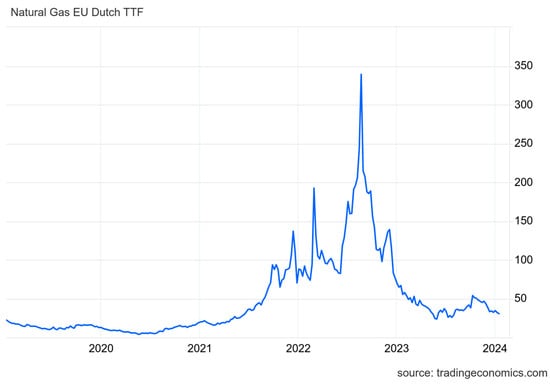
Figure 1.
Natural gas price in EU Dutch TTF.
The price of natural gas can vary widely, depending on several factors such as location, market conditions, and whether the gas is being used for residential, commercial, or industrial purposes. Additionally, prices are subject to change over time. The authors selected the following price for the calculations as it corresponds to the local Latvian market:
PH2 = 5 EUR/m3
The price of hydrogen can vary widely and is influenced by factors such as production method, purity, and regional market conditions. It is important to note that hydrogen is not as widely traded or standardized as natural gas, so prices can vary more. Based on https://www.indexbox.io/blog/spain-hydrogen-price-in-october-2022/ (accessed on 5 January 2024), the price of hydrogen varied notably with the country of origin; for instance, the country with the highest price was Portugal (7.8 USD/m3), while the price in the Netherlands was lowest, at 1.6 USD/m3. For demonstration purposes, the authors selected a price slightly above the average, but this parameter can be changed to adapt for the local conditions in other countries.
HVNG = 37.8 MJ/m3 (the approximate heat value for natural gas in Latvia)
Heat value is country and pipeline dependent and, according to [31], can be in the range from 34 to 52 MJ/m3.
HVH2 = 12.7 MJ/m3
This value is based on [32].
Equations for calculations:
3. Results and Discussion
For the presentation and analysis of results, the authors selected t = 21600 s (6 h) and AmountH2 = 10%. For scientific and technical reasons, it is considered possible to introduce up to 20% of hydrogen without any negative impact on end-users, infrastructure, or pipelines. All calculations were performed in MS Excel (version: Microsoft Office Professional Plus 2019) spreadsheet software. Afterwards, to present the calculations and results of the economic evaluation, a single page web application was developed. It was built using R [33], a language and environment for statistical computing. The main R packages that were used for application development were Shiny [34] (WEB application development) and Plotly [35] (graphing library).
Users are allowed to change several parameters such as: amount of H2 in the gas blend, consumption speed of the gas blend, prices, and heat values. See Figure 2 for user input. Total costs and final results for each input are updated after the button “Calculate” is clicked. The developed calculator is available for public use by accessing: https://bioekonomika.lbtu.lv/H2Calc/ (accessed on 20 January 2024).
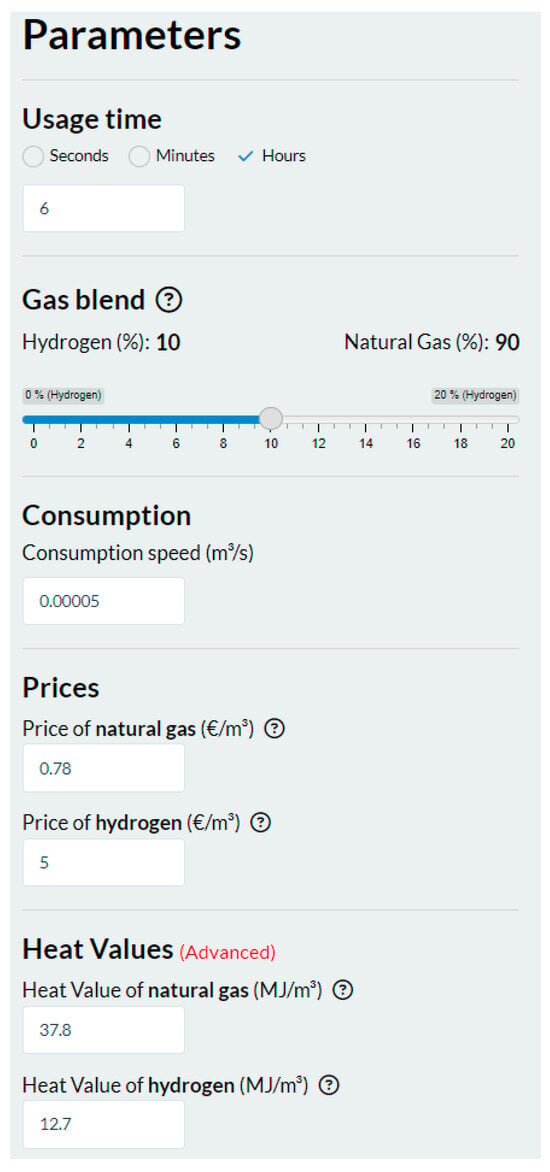
Figure 2.
User input for the calculations.
At the first iteration, costs are calculated considering only the price of the gases (natural and hydrogen) and the composition of the gas blend.
At the second calculation phase, differences in heat values are taken into account, and the reduction of CO2 is calculated. The results section shows: HVpotential, HVblend, HVmissing, ReductionCO2, Amountadd, Voladd (see Figure 3).
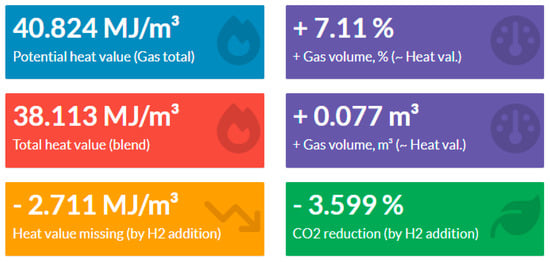
Figure 3.
Calculation results of the heat values.
At the final iteration, costs are updated by considering the missing heat value of the blend and the necessity to increase the gas blend to obtain the potential heat value that could be achieved if only natural gas was used. Figure 4 shows the comparison between the first iteration and final gas volumes and costs. It demonstrates gas volumes (Volblend, VolH2, VolNG) and gas costs (CH2, CNG, Ctotal) for two iterations. Volume and costs are presented for the whole gas volume consumed.

Figure 4.
Comparison between first iteration and final volume (a) and costs calculations (b).
At the end, for the given example, the potential natural gas costs, without blending with hydrogen, are 0.842 EUR. In contrast, with blending with hydrogen, the costs are 65.06% higher, at 1.39 EUR (see Figure 5). Initially, this means that from the consumer point of view, blending hydrogen with natural gas is not economically feasible.

Figure 5.
Comparison of costs.
When running the calculations for different amounts of hydrogen in the gas blend, different values are obtained (see Figure 6). As a baseline, a gas blend with 0% hydrogen is considered and taken as a reference point. Then, blends with different amounts of hydrogen are compared (1%, 5%, 10%, and 20%). It can be observed that the decrease of the CO2 is not equal to the decrease in the gas blend heat value. Further, the cost of the gas blend is increasing with the addition of hydrogen to the blend.
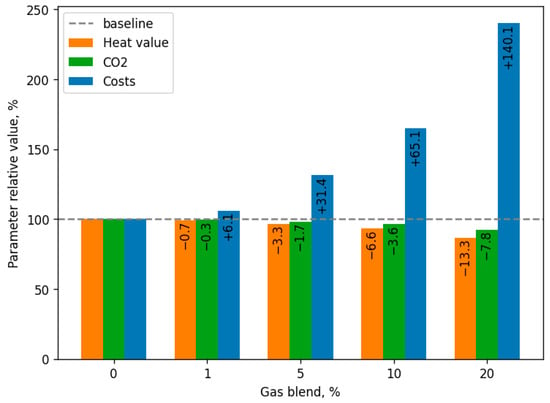
Figure 6.
Comparison of values with different amounts of hydrogen in the gas blend.
Figure 7 below shows changes in the heat values and CO2 for different amounts of hydrogen in the gas blend. Figure 8 shows changes in the cost of the gases in the blend when changing the proportion of hydrogen in the blend. Cost is calculated for the total volume of gas consumed (based on user input).
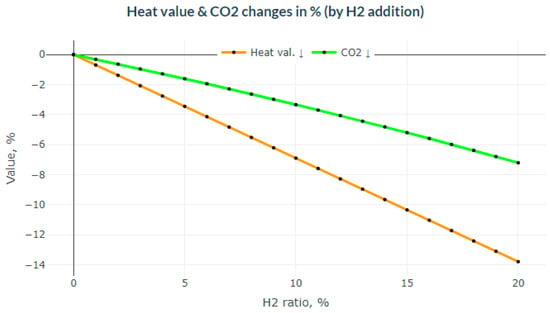
Figure 7.
Heat value and CO2 changes in the gas blend for different amounts of hydrogen added.
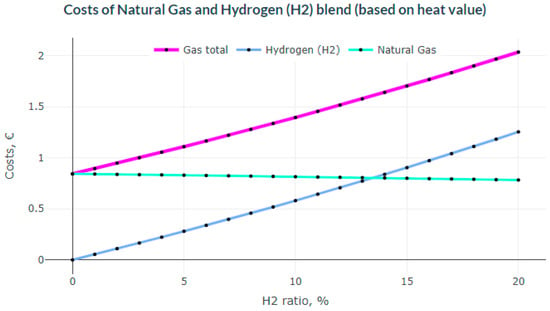
Figure 8.
Changes in the cost of the gas blend for different amounts of hydrogen added.
Figure 6 shows the relationship between heat value losses and the decrease in carbon dioxide emissions due to the presence of hydrogen in the gas blend. The loss in heat value with increasing hydrogen concentration in the gas blend can certainly be considered a negative fact from an energy point of view. At the same time, a very positive ecological effect is the reduction in carbon dioxide emissions. In this case, the difference between the ratios of these two indicators directly depends on the heat value of the two gases.
Changes in the ratio of hydrogen to natural gas also affect the cost of the total gas blend (see Figure 8). If we consider that the cost of hydrogen is much higher than the cost of natural gas, then the price of the total gas blend rapidly increases with increasing hydrogen concentration. Meanwhile, the impact of a decrease in natural gas concentration on the overall cost can be considered insignificant.
It is worth analyzing the economic thresholds where the blending of hydrogen and natural gas becomes economically feasible. Figure 9 below shows the potential change in overall costs based on hydrogen price.
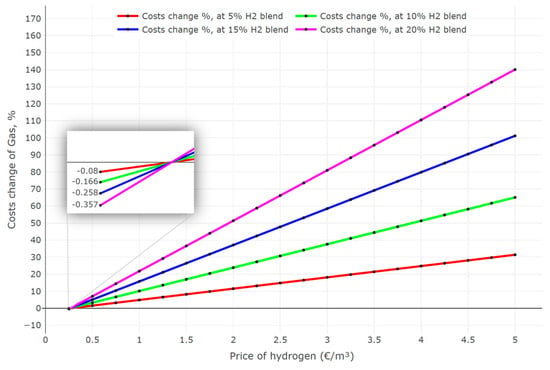
Figure 9.
Changes in the overall cost of the gas blend based on the hydrogen price.
The following results are obtained by changing the potential price of hydrogen. The cost of the gas blend depends on the price of hydrogen and on the concentration of hydrogen in the gas mix. The plot in Figure 9 shows the cost changes in % that result from increasing the concentration and price of hydrogen. The price of natural gas is fixed in this case at 0.78 EUR/m3. As can be seen, a mixture with a higher concentration of hydrogen has a sharper increase in cost as the cost of hydrogen increases. Only if the cost of hydrogen is very low (in this case, 0.25 EUR/m3) can the introduction of hydrogen make the gas blend economically feasible.
4. Conclusions
Adding hydrogen to existing natural gas networks can bring several benefits. Producing hydrogen from renewable sources will result in a decrease in greenhouse gas emissions. Utilizing a blend of hydrogen and natural gas with current equipment for heating, cooking, or cogeneration diminishes the environmental impact of natural gas combustion. The advantages of such an approach, akin to augmenting the renewable energy mix, are achieved without necessitating substantial modifications to end-user equipment.
The economic evaluation of mixing hydrogen with natural gas represents a pivotal exploration into the potentially transformative impact of this hybrid energy solution. Through a comprehensive analysis of various aspects, including cost-effectiveness, environmental considerations, and market dynamics, several key insights have emerged.
The economic viability of blending hydrogen with natural gas depends on advancements in technology and infrastructure development. While the initial investment costs may be significant, the long-term benefits in terms of reduced greenhouse gas emissions and enhanced energy security present a compelling case for the integration of hydrogen into existing natural gas networks. Unfortunately, from an economic point of view, resulting costs for the end consumer are not feasible at this moment, as costs are increased by up to 140.1%.
The economic evaluation emphasizes the importance of policy frameworks and regulatory support. Incentives and clear guidelines can accelerate the adoption of hydrogen–natural gas blends, fostering a conducive environment for both public and private sector investments.
In the realm of societal implications, the utilization of the hydrogen–natural gas blend can yield noteworthy outcomes. Hydrogen, when employed in fuel cells for powering vehicles and buildings, has the potential to generate new employment opportunities and stimulate economic growth. Furthermore, the local production and transportation of hydrogen contributes to lowering expenses associated with accessing energy sources.
In conclusion, the economic evaluation of mixing hydrogen with natural gas not only highlights the challenges and opportunities associated with this emerging energy paradigm, but also highlights its potential to play a crucial role in achieving a more sustainable and resilient energy future. As we navigate the complexities of our energy landscape, this research serves as a valuable guidepost for policymakers, industry leaders, and researchers alike, paving the way for a cleaner and more economically viable energy mix.
The developed calculator provides an economic evaluation of hydrogen and natural gas blending and is freely available for public access at: https://bioekonomika.lbtu.lv/H2Calc/.
Author Contributions
Conceptualization, A.Z. and D.K.; methodology, A.Z. and A.K.; software, D.K.; validation, all authors; writing—original draft preparation, A.Z. and V.K.; writing—review and editing, D.K. and A.K. All authors have read and agreed to the published version of the manuscript.
Funding
The scientific research and publication of this article were supported by the ERA–NET Project “New technology to produce hydrogen from Renewable Energy Sources based on AI with optimized costs for environmental applications” (HydroG(re)EnergY-Env, No. 112068).
Data Availability Statement
The original contributions presented in this study are included in the article; further inquiries can be directed to the corresponding author.
Conflicts of Interest
The authors declare no conflicts of interest.
References
- Zakaria, Z.; Kamarudin, S.K.; Salehmin, M.N.I.; Ahmad, N.N.R.; Aminuddin, M.A.; Hanapi, I.H.; Osman, S.H.; Mohamad, A.A. Energy scenario in Malaysia: Embarking on the potential use of hydrogen energy. Int. J. Hydrogen Energy 2023, 48, 35685–35707. [Google Scholar] [CrossRef]
- Frigo, G.; Baumann, M.; Hillerbrand, R. Energy and the good life: Capabilities as the foundation of the right to access energy services. J. Hum. Dev. Capab. 2021, 22, 218–248. [Google Scholar] [CrossRef]
- Dogaru, L. The main goals of the fourth industrial revolution. Renewable Energy Perspectives. Procedia Manuf. 2020, 46, 397–401. [Google Scholar] [CrossRef]
- Mukelabai, M.D.; Wijayantha, K.G.U.; Blanchard, R.E. Hydrogen technology adoption analysis in Africa using a Doughnut-PESTLE hydrogen model (DPHM). Int. J. Hydrogen Energy 2022, 47, 31521–31540. [Google Scholar] [CrossRef]
- Jaramillo, L.B.; Weidlich, A. Optimal microgrid scheduling with peak load reduction involving an electrolyzer and flexible loads. Appl. Energy 2016, 169, 857–865. [Google Scholar] [CrossRef]
- Salvi, B.L.; Subramanian, K.A. Sustainable development of road transportation sector using hydrogen energy system. Renew. Sustain. Energy Rev. 2015, 51, 1132–1155. [Google Scholar] [CrossRef]
- Liu, W.; Zuo, H.; Wang, J.; Xue, Q.; Ren, B.; Yang, F. The production and application of hydrogen in steel industry. Int. J. Hydrogen Energy 2021, 46, 10548–10569. [Google Scholar] [CrossRef]
- Pudukudy, M.; Yaakob, Z.; Mohammad, M.; Narayanan, B.; Sopian, K. Renewable hydrogen economy in Asia—Opportunities and challenges: An overview. Renew. Sustain. Energy Rev. 2014, 30, 743–757. [Google Scholar] [CrossRef]
- Ehret, O.; Bonhoff, K. Hydrogen as a fuel and energy storage: Success factors for the German Energiewende. Int. J. Hydrogen Energy 2015, 40, 5526–5533. [Google Scholar] [CrossRef]
- Ge, Y.; Han, J.; Zhu, X.; Zhu, W.; Yang, J. A combined cooling, heating and power system with energy storage of waste heat to hydrogen. Appl. Therm. Eng. 2023, 225, 120224. [Google Scholar] [CrossRef]
- Ebrahimi-Moghadam, A.; Farzaneh-Gord, M. Optimal operation of a multi-generation district energy hub based on electrical, heating, and cooling demands and hydrogen production. Appl. Energy 2022, 309, 118453. [Google Scholar] [CrossRef]
- Ausfelder, F.; Bazzanella, A. Hydrogen in the chemical industry. In Hydrogen Science and Engineering: Materials, Processes, Systems and Technology; John Wiley & Sons, Inc.: Hoboken, NJ, USA, 2016; pp. 19–40. [Google Scholar]
- Rambhujun, N.; Salman, M.S.; Wang, T.; Pratthana, C.; Sapkota, P.; Costalin, M.; Lai, Q.; Aguey-Zinsou, K.F. Renewable hydrogen for the chemical industry. MRS Energy Sustain. 2020, 7, E33. [Google Scholar] [CrossRef]
- Dincer, I.; Acar, C. A review on potential use of hydrogen in aviation applications. Int. J. Sustain. Aviat. 2016, 2, 74–100. [Google Scholar] [CrossRef]
- Li, B.; Roche, R.; Paire, D.; Miraoui, A. Sizing of a stand-alone microgrid considering electric power, cooling/heating, hydrogen loads and hydrogen storage degradation. Appl. Energy 2017, 205, 1244–1259. [Google Scholar] [CrossRef]
- Ustolin, F.; Campari, A.; Taccani, R. An extensive review of liquid hydrogen in transportation with focus on the maritime sector. J. Mar. Sci. Eng. 2022, 10, 1222. [Google Scholar] [CrossRef]
- Van Hoecke, L.; Laffineur, L.; Campe, R.; Perreault, P.; Verbruggen, S.W.; Lenaerts, S. Challenges in the use of hydrogen for maritime applications. Energy Environ. Sci. 2021, 14, 815–843. [Google Scholar] [CrossRef]
- Irimia-Vladu, M.; Kanbur, Y.; Camaioni, F.; Coppola, M.E.; Yumusak, C.; Irimia, C.V.; Vlad, A.; Operamolla, A.; Farinola, G.M.; Suranna, G.P.; et al. Stability of selected hydrogen bonded semiconductors in organic electronic devices. Chem. Mater. 2019, 31, 6315–6346. [Google Scholar] [CrossRef]
- Penev, M.; Zuboy, J.; Hunter, C. Economic analysis of a high-pressure urban pipeline concept (HyLine) for delivering hydrogen to retail fueling stations. Transp. Res. Part D Transp. Environ. 2019, 77, 92–105. [Google Scholar] [CrossRef]
- AlShafi, M.; Bicer, Y. Assessment of various energy storage methods for implementation in hot and arid climates. Energy Storage 2020, 2, e191. [Google Scholar] [CrossRef]
- Vidas, L.; Castro, R.; Pires, A. A review of the impact of hydrogen integration in natural gas distribution networks and electric smart grids. Energies 2022, 15, 3160. [Google Scholar] [CrossRef]
- Ohaeri, E.; Eduok, U.; Szpunar, J. Hydrogen related degradation in pipeline steel: A review. Int. J. Hydrogen Energy 2018, 43, 14584–14617. [Google Scholar] [CrossRef]
- Mahajan, D.; Tan, K.; Venkatesh, T.; Kileti, P.; Clayton, C.R. Hydrogen blending in gas pipeline networks—A review. Energies 2022, 15, 3582. [Google Scholar] [CrossRef]
- Kappes, M.A.; Perez, T. Hydrogen blending in existing natural gas transmission pipelines: A review of hydrogen embrittlement, governing codes, and life prediction methods. Corros. Rev. 2023, 41, 319–347. [Google Scholar] [CrossRef]
- Neacsa, A.; Eparu, C.N.; Stoica, D.B. Hydrogen–natural gas blending in distribution systems—An energy, economic, and environmental assessment. Energies 2022, 15, 6143. [Google Scholar] [CrossRef]
- Glanville, P.; Fridlyand, A.; Sutherland, B.; Liszka, M.; Zhao, Y.; Bingham, L.; Jorgensen, K. Impact of hydrogen/natural gas blends on partially premixed combustion equipment: NOx emission and operational performance. Energies 2022, 15, 1706. [Google Scholar] [CrossRef]
- Tan, K.; Mahajan, D.; Venkatesh, T.A. Computational fluid dynamic modeling of methane-hydrogen mixture transportation in pipelines: Estimating energy costs. MRS Adv. 2022, 7, 388–393. [Google Scholar] [CrossRef]
- Leicher, J.; Schaffert, J.; Cigarida, H.; Tali, E.; Burmeister, F.; Giese, A.; Albus, R.; Görner, K.; Carpentier, S.; Milin, P.; et al. The impact of hydrogen admixture into natural gas on residential and commercial gas appliances. Energies 2022, 15, 777. [Google Scholar] [CrossRef]
- Neacsa, A.; Eparu, C.N.; Panaitescu, C.; Stoica, D.B.; Ionete, B.; Prundurel, A.; Gal, S. Hydrogen–Natural Gas Mix—A Viable Perspective for Environment and Society. Energies 2023, 16, 5751. [Google Scholar] [CrossRef]
- Couturier, M. Natural Gas + H2 Blend Calculation. 2023. Available online: https://www.linkedin.com/pulse/natural-gas-h2-blend-calculation-marc-couturier (accessed on 29 September 2023).
- MET Group. Calorific Value of Natural Gas (MJ/M3 AND BTU/SCF). 2021. Available online: https://group.met.com/en/media/energy-insight/calorific-value-of-natural-gas#:~:text=What%20is%20the%20heat%20value,to%201%2C050%20BTU%2FSCF (accessed on 11 October 2023).
- Ali, I.; Basit, M.A. Significance of hydrogen content in fuel combustion. Int. J. Hydrogen Energy 1993, 18, 1009–1011. [Google Scholar] [CrossRef]
- R Core Team. R: A Language and Environment for Statistical Computing; R Foundation for Statistical Computing: Vienna, Austria, 2023; Available online: https://www.R-project.org/ (accessed on 20 November 2023).
- Chang, W.; Cheng, J.; Allaire, J.; Sievert, C.; Schloerke, B.; Xie, Y.; Allen, J.; McPherson, J.; Dipert, A.; Borges, B. Shiny: Web Application Framework for R. R package version 1.8.0.9000. 2023. Available online: https://shiny.posit.co/ (accessed on 20 November 2023).
- Sievert, C. Interactive Web-Based Data Visualization with R, Plotly, and Shiny; Chapman and Hall/CRC: Boca Raton, FL, USA, 2020; Available online: https://plotly-r.com (accessed on 20 November 2023).
Disclaimer/Publisher’s Note: The statements, opinions and data contained in all publications are solely those of the individual author(s) and contributor(s) and not of MDPI and/or the editor(s). MDPI and/or the editor(s) disclaim responsibility for any injury to people or property resulting from any ideas, methods, instructions or products referred to in the content. |
© 2024 by the authors. Licensee MDPI, Basel, Switzerland. This article is an open access article distributed under the terms and conditions of the Creative Commons Attribution (CC BY) license (https://creativecommons.org/licenses/by/4.0/).